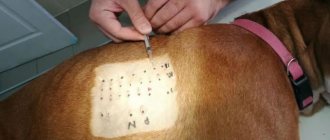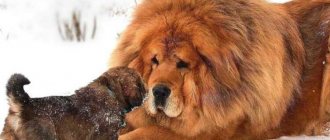The owner of a pregnant dog, especially if this is happening to her for the first time, needs to know what the normal duration of pregnancy is, how the babies develop, and what their mother needs. All this will help to get healthy offspring and not harm the female.
Read a detailed article on the topic: “Everything you need to know about breeding dogs: appropriate age, what to do if it doesn’t work out, rules and tips.”
Gestation period in dogs
Pregnancy in females lasts 56–72 days . More often it lasts about 63 days . The countdown starts from the mating date. A duration longer or shorter than the specified periods is a pathology and requires a visit to the veterinarian, because there is a threat to the life of both mother and babies.
Factors influencing the duration of pregnancy
The length of pregnancy varies slightly between dogs. Its duration depends on:
- The size of the expectant mother.
- Orders of pregnancy. The first wait for puppies usually lasts longer.
- Pet's age. The older the dog, the longer the pregnancy.
- Number of puppies. When several babies are present, labor begins earlier.
- Accuracy of determining the date of fertilization. Pregnancy may not occur immediately after mating, but within 5-7 days, so the countdown may be incorrect.
Detailed description of pregnancy: calendar by day
The table below gives an idea of the development of babies, as well as the manifestation of symptoms of pregnancy in a female and the care necessary for her.
| Duration, days | Fetal development | Condition of the dog, care for it |
| 1-2 | The ovulated egg is released from the ovary, and sperm are sent to it. | The mother's behavior does not change, there are no external manifestations of pregnancy. There is no need to change the diet, frequency of walking, number and nature of games. However, overvoltage must be avoided. |
| 3-4 | A zygote is formed. This occurs due to the connection of the egg with the sperm, which has reached the fallopian tubes leading to the uterus. | |
| 5-11 | The zygotes descend into the uterus, becoming covered with “embryonic membranes” as they move. | |
| 12-14 | Embryos are about 0.6 mm long. They reach the walls of the uterus and attach to them. The placenta is formed from the outer shell of the zygote and the mucous membrane of the organ. | |
| 15-16 | The embryos are approximately 1 mm. In length. The formation of internal organs begins | The dog is losing some hair around the nipples. The mammary glands swell and turn pink. The animal is sensitive and receptive. It is necessary to protect the expectant mother from negative effects on the body and psyche, changes in environment, schedule, and nutrition. It is prohibited to vaccinate, treat against helminths, or use anti-tick and other insect repellents. |
| 17-19 | The size of the embryo is 2 mm. The skull, spine, body, internal organs and central nervous system begin to form. | |
| 20-21 | The size of the embryo is 5 mm. When performing an ultrasound, you can detect the membranes of the fetus (it itself is invisible). The heart is formed. | |
| 22-24 | The embryo reaches 1 cm and becomes accessible to detection using ultrasound. The visible organs of the head are formed - the eyeballs, jaws, nose and ears, as well as the liver. | The dog becomes lethargic and apathetic, often sad, does not want to play, and refuses its usual food. Manifestations of toxicosis begin - the animal feels sick and sometimes vomits. There may be a small amount of discharge from the loop, clear or slightly whitish in color. It is necessary to reduce the volume of food per serving, but gradually increase the frequency of its intake, as the germs begin to put pressure on the stomach. |
| 25 | The dimensions of the embryo are 1.4 cm. The front and hind legs develop, and teeth are formed. | |
| 26 | The embryo reaches 1.5 cm. The veterinarian can detect embryos by palpating the peritoneum. | From now on, outdoor games, running and jumping are minimized so as not to harm the babies. |
| 27-29 | Puppies grow up to 1.7 cm. They are clearly visible on ultrasound and can be distinguished by palpation. The skull and jaws begin to fill with calcium. | |
| 30-31 | The babies grow up to 2 cm. Sensory antennae begin to form near the mustache, eyebrows, and on the chin. | Moms begin to add calcium to their diet. |
| 32-35 | The height of the babies is 2.7 cm. The fetus is actively growing, the limbs and ribs are strengthening, and the palate is tightening. | The expectant mother's belly is noticeably growing. She becomes calm, quiet, affectionate. The dog's appetite increases significantly. Because of this, the amount of feed is increased by 10%, and given in small portions and more often than usual. During this period, the use of any medications is prohibited, as this leads to disturbances in the formation of the skeleton and jaw apparatus, for example, to a “cleft palate”. |
| 36 | The baby's size is 3.5 cm. The formation of the body's systems has been completed, bones continue to grow, and the shoulder blades are taking shape. Signs of sex appear, and fur begins to appear. | |
| 37-40 | Fetal growth is 6.5 cm, active and rapid development is underway. The bones, spinal column, all internal organs are finally formed, fingers and eyes are visible. | |
| 41-44 | Formed bones continue to grow. Upon palpation, the fruits are clearly visible, but their quantity is difficult to determine. | The dog's uterus occupies most of the peritoneum. The nipples are noticeably enlarged and the hair around them is completely absent. The volume of feed is increased by 20% compared to the original norm, portions are made very small. Any increased activity is excluded. |
| 45-47 | The fruits are up to 9 cm long. The pelvic bones and wool grow. | |
| 48-50 | Puppies are about 12 cm, the body is completely formed. You can observe the movement of babies in the abdominal area. | The bitch constantly licks her mammary glands, becomes restless, fussy, and looks for a “nest.” Appetite may completely disappear or decrease. The food portion is increased to 50% compared to the usual dose. The females are prepared for a place to give birth and are gradually accustomed to it. |
| 51-54 | Puppies are visible on x-rays and their number can be determined. | A small amount of milk is released from the nipples. The dog lies down or licks itself. Females remove calcium from the menu. |
| 55-59 | The size of the fetus is 15 cm. The teeth are finishing forming. | Colostrum leaves the mammary glands. Childbirth can occur at any time. The dog's body temperature is measured daily; before the babies are born, it should drop sharply. Prepare all the necessary tools and materials to help the dog. |
| 60-62 | The babies are 16 cm tall. The fur completely covers the body. | |
| 63-65 | Childbirth begins and amniotic fluid breaks. Puppies appear with their eyes closed, average height is 16-22 cm, weight is about 0.3-0.6 kg (less for small breeds). |
Life has shown (sometimes with sad examples) that this knowledge is still a “closed secret” for many owners of bitches.
We will talk about introducing calcium and vitamin supplements into the puppy's diet . In order not to be unfounded, we will refer to the most authoritative American textbook today, Kirk’s Complete Course of Veterinary Medicine, translated from English in 2005 by the Aquarium publishing house.
In the section “Obstetrics and Gynecology” (authors Myers-Valentin and Schweitzer), in large print there is an appeal to veterinarians: “Prohibit breeders from giving pregnant bitches any calcium supplements!”
The bitch's need for this mineral actually increases as the embryos grow, but this need is fully satisfied by increasing the amount of food eaten. Artificial introduction of calcium into the diet often leads to the opposite result - blocking the hormonal function of the parathyroid glands , leading to uterine laxity during childbirth and hypocalcemia (eclampsia), or more correctly, tetany in the postpartum period. The authors also warn against the use of other food additives, especially fat-soluble vitamins A and D. It has been experimentally proven that the accumulation of these vitamins in the body of a female dog can not only cause serious harm to her health, but also to the health of future offspring. Thus, an excess of vitamin A causes cleft palate (“cleft palate”) in fetuses, and vitamin D can provoke cryptorchidism in male dogs, and also cause difficulty in the movement of calcium in the body (between blood plasma, bones, growing embryos) of the female, disrupting the normal course pregnancy. The only supplement that can only bring benefits are folates, i.e. B vitamins , firstly, which are scarce for predators, and secondly, do not accumulate in the body and have a beneficial effect on the development of embryos.
Let's talk about the importance of measuring temperature before childbirth . The fact that a drop in temperature to 37 (or lower) indicates that the pregnancy is over! Those. The puppies not only have to be born within the next 24 hours, but they simply have to do it!
I will quote the same textbook again. Myers-Valentin and Schweitzer consider the following obstetric pathologies requiring urgent (!) attention:
1. Absence of the 1st stage of labor (contractions, cervical dilatation) 6–18 hours after the temperature drops or absence of 1–2 stages of labor itself after 24 hours.
2. Absence of the 2nd stage of labor (pushing) 6–18 hours after the onset of contractions.
3. One hour of weak, barely noticeable pushing or 20 minutes of strong, intense pushing, i.e., if the temperature has dropped and nothing happens within 24 hours, worry!
Why, despite the mother’s efforts, does the baby not hurry outside? The reasons may be simple, but not always. Maybe the puppy is lying incorrectly - with his forehead, the back of his head, with his head turned, etc. If he is alive, there is a high probability that he will correct his position on his own. If the puppy is dead, the situation will only get worse. There are also deformities of the fetus - for example, anasarca (swelling of the subcutaneous tissue), in which the volume of the fetus can increase several times, and it becomes like a rubber heating pad overfilled with water (as a rule, anasarca is accompanied by other deformities, for example, “cleft palate”) .
You may not believe it, but I once had to extract a puppy with five legs from an Asian woman. The two left front ones prevented him from being born normally. Unfortunately, the breeders categorically refused to give this “miracle” to the clinic’s museum and buried it with honors. Although there was nothing special in this case: for example, we have a puppy with 8 legs (two front and six back) stored in a formaldehyde jar.
Sometimes it’s not the puppy; vaginal anomalies are not so rare - adhesions and septa, which, by the way, are sometimes inherited by the daughter from the mother. They are usually easy to remove surgically.
I also want to remind you that the calmness of a bitch is not a sign of the end of labor ! It can be caused by a variety of reasons, ranging from basic fatigue to uterine rupture or necrosis.
Where should a dog give birth? It is usually recommended to build a playpen (box) for the dog and let it get used to being in it with the puppies. I would like to focus on two points:
1. Size of the playpen. It is not uncommon to see how a shepherd dog, or even a larger dog, is placed to give birth in a box in which it can barely fit. The puppies that are born grow very quickly, but the mother is cramped, it is difficult for her to even turn around. Crowding often leads to the fact that the bitch is forced to crush her own children.
The optimal size of the playpen is calculated using a simple formula: the side of the square is equal to 1.5 times the length of the dog (counting from the tip of the nose of the dog lying on its side to the base of its tail). The floor of the playpen is covered with soft bedding (blanket, sheet of foam rubber), covered with oilcloth and replaceable sheets. After a couple of weeks, half of the playpen is cleared of the sleeping area and covered with newspapers, as the puppies are already beginning to leave the nest for their urgent matters.
But you should not give birth in a playpen prepared for a mother and her offspring. Firstly, if help is needed, it is inconvenient to provide it in it. Secondly, no oilcloth will protect the soft bedding from getting wet. The amount of water, blood and mucus during childbirth usually makes a strong impression on novice obstetricians, and after the end of labor there is simply nowhere to put the bitch. It is better for a bitch to give birth simply on the floor, covered with a thick layer of newspapers, which have already received the honorary title of “our free diapers” from the breeders. They can be quickly removed and replaced with dry ones.
2. The dog gives birth at your home! True, there are also owners who believe that they need to be “closer to nature.” I will never forget one Caucasian Shepherd dog, which the owners arranged to give birth in the bathhouse in winter. In fact, the bathhouse turned out to be a summer shower, with an icy floor and a blizzard walking between the sparsely nailed planks. The owners motivated this by the fact that “in nature, Caucasians live on the street.” It was very difficult to explain to them that “there” they give birth not in January, but in the spring, in a dug den. When we entered the “bathhouse,” we saw six puppies lying silently and motionless on the icy floor and a bitch preparing to give birth to another cub. You might ask - what about the mother? Why didn’t she bring her freezing children into one heap and lie down next to them? There are two interesting answers here: firstly, the instinct of carrying puppies to the nest begins to work in the bitch only after the complete end of labor (and disappears exactly on the 13th day after it), and, secondly, a puppy whose temperature is below critical ( somewhere 32 degrees), is no longer perceived by the mother as a living being in need of care. I don’t know what the temperature of these Caucasians was, but a finger stuck in their mouth felt like being in a pack of ice cream, and there were no tongue movements either. We warmed them up for about forty minutes in a basin of warm water, and only after that did they begin to move and were able to suck.
Puppies staying with their mother in an apartment do not need additional heating. I had to read in some veterinary publications that the temperature in the room should not be lower than 30 degrees. I don’t know what will happen to the dog, but the owners are unlikely to survive! Moreover, all kinds of heating pads, radiators, etc. are dangerous. Overheating for puppies who do not yet have thermoregulation is even more dangerous than cold!
When going for a walk with the bitch, you can cover the puppies with something warm, but (!) before letting the mother back in, be sure to uncover the puppies. Otherwise, she will definitely try to lie down on top of the puppies, and, quite possibly, will crush them.
So, we give birth on newspapers. What is required from the dog and from us? From the bitch - timely awakening of normal natural instincts, from us - vigilant attention, a minimum of special knowledge and, as experience shows, basic common sense.
Let me give you examples:
— After long, not too strong attempts, the dog appeared to have a bubble filled with liquid appear from the loop (this often happens in small breeds, but with polyhydramnios it can also happen in large ones). In this case, it is better either not to touch the bubble at all, or you can carefully open it until the liquid flows out. But the owners of one small Shih Tzu read somewhere that the dog “can give birth to empty bladders that need to be pulled out” (the source of this information could not be determined). They pulled it out... along with the placenta, leaving the puppy suffocating inside. I’m still not sure that I managed to explain to adults why the puppy is dead and what the placenta is for!
— A live baby was born. He crawled and squeaked. But the breeders read somewhere that they need to suck out the fluid from the lungs. The liquid still did not come out, and the owners, changing each other, sucked and sucked for a whole 3 hours! In the end, the puppy died - his weak lungs either simply collapsed or hemorrhaged.
Remember: if the cub squeaks, its lungs are already functioning, and if there really is something to “suck”, then pay attention! – it should be a “light kiss” - the way you kiss a child on the cheek!
— Another example of the fantastic lack of signs of intelligence in a breeder: at night I am called to a small dog giving birth. I arrive as soon as possible and find a sad sight: a dog (Yorkie) is running around the apartment, and behind it a puppy is dragging along the floor, whose head is stuck in a noose. I ask - how long has it been like this? No, they say, half an hour, no more! We put the dog on the table, and then I see that the umbilical cord has been carefully cut and tied! "What is this?" - I ask. “Well, the umbilical cord needs to be cut and tied,” the hostess answers confidently. “What should he breathe?” “But he wasn’t born yet,” the answer shocks me.
In such a situation, when the puppy is stuck at the level of the shoulders or head , the right thing to do is to try to remove it yourself - he simply will not live until the doctor arrives. The umbilical cord is either broken or pinched. The minutes count! And forget about “strict compliance with contractions and pushing,” as they say in many books. Get it, this is his only chance to live! It is best to grab the puppy through the gauze (so as not to slip) by the skin on the back, with the finger of the other hand (clean!) try to free the shoulders, and may God help you!
It is not my task to present a complete course of obstetrics; I just want to warn beginners against fatal mistakes. We have already talked about how important it is to make sure that the birth is completed. The puppies that emerge must suckle from their mother. True, there are nuances here too. I had to meet the owners of a Shar Pei - an adult daughter and her elderly mother. They called me the day after giving birth, because the bitch was starting to have mastitis! This saved the lives of six puppies who had been lying in a box with a heating pad in another room all this time! It turns out that breeders read somewhere that puppies begin to be fed on the third day after birth!
Puppies should eat immediately, every 2 hours , unless for some reason they are under the bitch all the time. And most importantly, the first 48 hours are the most important in the mother’s feeding of puppies. The fact is that colostrum (more precisely, the so-called colostrum corpuscles) is able to penetrate into the intestines of the baby only during this time! Even if on the third day you place the puppy next to a wet nurse who has just whelped, there will be no benefit from this. If you are two days late, you will be late for life. But it is through colostrum that the baby receives immunity from the mother (the so-called maternal or colostral), which will protect the puppies in the first months of their life. By the way, this is why it is so important to vaccinate breeding bitches! And if for some reason you forgot or did not have time to do this before mating, keep in mind that modern vaccines such as Nobivak or Eurikan are allowed to be used during pregnancy. Maternal immunity is the best gift for a newborn!
And finally, I would like to remind you about deworming puppies . Modern drugs allow you to do this starting from 14 days of age, but for some reason many breeders delay giving drugs until 21 or even 30 days. This is inappropriate, because toxocara, which is usually a parasite in puppies up to the age of 2.5 months, is far from harmless. During migration, the larvae violate the integrity of the tissues of the lungs and intestines, and can clog the intestines or bile ducts, pancreatic ducts. If this happens, the puppy dies in terrible agony and it is impossible to help him. In addition, Toxocara secretes strong toxins. Please note that with intrauterine infection (the most common for puppies), by the 21st day of his life, already sexually mature helminths that secrete eggs live in his intestines!
Follow the generally accepted practice, drive them to the neck!
Author: M. V. Vinogradova, veterinarian
based on materials from the site https://www.biglik.ru/
Preparing for childbirth
About a week before the expected date of birth, you need to take care of a comfortable place for the “nest” in which the birth will take place and the puppies will be with their mother. The structure must be closed on 4 sides so that the animal feels calm and safe. The house must be positioned so that the owner and veterinarian can gain access to the mother and babies if necessary.
Be sure to prepare items that will be useful during the birth process and immediately after it. These include:
- Sterile bandages and gauze (to wipe babies);
- Absorbent or rubberized diaper (on the floor in the house);
- Iodine, brilliant green, cotton pads for treating the umbilical cord;
- Medical rubber “bulb” (to remove mucus from the puppy’s nose);
- Sterile scissors and threads (for tying and cutting the umbilical cord);
- Scales and a notebook to record information about the sequence of appearance and weight of the puppies;
- Multi-colored woolen threads (tie around the neck to distinguish the babies);
- formula for newborn pets and a heating pad, in case of complications of the mother’s condition or her reluctance to feed.
Detailed article on the topic: “Features of childbirth in a dog: preparation, symptoms, care.”
The length of time you wait for puppies depends not only on their number, but also on the size of the female, her age and how pregnant she is. By following the recommendations for caring for the mother, as well as observing her condition, you can monitor the development of the babies, as well as prepare everything necessary for their birth in time.
4.7 / 5 ( 3 voices)
Spaniel pregnancy. Second phase
From the fourth week of pregnancy, you should pay special attention to the dog’s nutrition. It should contain enough calcium and minerals. If in the first month a dog should receive 65-70 mg of calcium per 1 kilogram of the dog’s weight, then in the fourth month it is advisable to increase it.
In the fifth week of pregnancy, consult your veterinarian. At this time, the number of fruits will be determined. Puppies begin to move around the eighth week of pregnancy, and this is when their heads are fully formed.
From the fourth to the sixth week, the dog needs three meals a day. Add meat, fish, and cottage cheese products to your diet. From the thirtieth day onwards, it is useful to add bone meal to the dog’s food, two tablespoons per day, as well as vitamin A. Do not overfeed the bitch; rapid weight gain can complicate childbirth.
Last days before giving birth
For dogs of rare breeds, especially those with difficult births, it is important to correctly calculate the timing of birth.
- Small breeds are characterized by a drop in temperature a day before the chicks appear. If the thermometer shows 37°C, most likely you need to adopt puppies tomorrow.
- The expectant mother begins to whine and look for a cozy corner. He is rearranging his bed. It is important that she is neither hot nor cold. Drafts are not allowed.
- Immediately before childbirth, the stomach drops and the sides fall in.
Large breed dogs tend to cope with childbirth easily. In dwarf dogs, the process is long and painful. Possible loss of offspring. If you don’t have confidence in your own abilities and knowledge, you should invite a specialist to help the animal.
Signs indicating that labor is approaching
As a rule, childbirth in dogs is quite calm and does not require human intervention. However, there are some signs that indicate certain complications during childbirth - for example, copious, colorless discharge or a situation where the dog is pushing with all her might, but the puppies are not coming out. If you notice anything like this during your pet's birth or have any other cause for concern, try to contact your veterinarian as soon as possible. You can find more detailed information about the birth of puppies on the corresponding page of our website.
Source
How to terminate a pregnancy
In some cases, it is necessary to resort to post-coital contraception and induced abortion. This is a responsible step on which the life and health of your pet depends. How to do this so as not to harm the dog's health?
Reasons for termination of pregnancy
- Unplanned (accidental) mating.
- Mating during the first heat of a young female.
- Disproportions in the sizes of males and females.
- Ectopic pregnancy.
- Dog health problems.
- Possible problems with offspring due to pathologies in the structure of the dog’s pelvis.
The sooner the termination is made, the greater the chance of maintaining the dog’s ability to have offspring. In veterinary medicine, two methods of ending pregnancy are used: medication and surgery. Both methods cause serious damage to the dog's health. They are recommended to be used only for serious medical reasons .
Medication method
This is a more gentle way. In veterinary medicine, injectable drugs and tablets are used. The choice of drug for induced abortion depends on the stage of pregnancy and the health of the dog.
Veterinarians use:
- Estrogen-based drugs. Used at the beginning of pregnancy. They have serious side effects: infertility, disruption of internal organs.
- Natural and synthetic analogues of prostaglandins. Used early. A more gentle way. Prescribed only after pregnancy is confirmed (ultrasound).
- Progesterone antagonists. Use up to 45 days after mating. They have contraindications and side effects.
- Corticosteroids. Used at a later date. Can cause serious complications, including death of the animal.
Important!
The decision to terminate is made only by a professional veterinarian. He will examine the animal, choose an acceptable method of termination and medications.
How puppies develop in the belly of a mother dog
Let's look at how babies develop while in the womb of a pregnant dog:
Photo: Jack Russell Terrier puppies | Dreamstime.com
- 1-2 weeks:
at the very beginning of pregnancy, embryos, covered with a protective bubble, make their way from the ovaries to the uterus, where they are fixed and grow; - 3-4 weeks:
Tiny embryos begin to form important internal organs, the nervous system and skeleton. The resemblance of ears, eyes, and nose is already noticeable on the head and muzzle. By the end of the 4th week of pregnancy, babies have antennae and eyelashes, and fur develops; - 5-6 weeks:
the embryos grow more and more actively, the bones become stronger. The primary sexual characteristics of male and female puppies are formed; - 7-8 weeks:
puppy teeth develop, fur appears on the face and belly. The internal organs are quite developed. By the end of 8 weeks, the puppies are practically formed and ready to see the world.
Russian hunting spaniel
Approximately 5-7 days before giving birth, the bitch experiences swelling of the mammary glands and slight swelling of the perineum and external genitalia.
Usually dogs give birth in a lying position, on their right side, but some puppies while standing.
Before the appearance of puppies, bitches exhibit characteristic straining. Sometimes the dog yelps painfully. You can stimulate sluggish efforts by massaging the lower back along the fur. The administration of medicinal stimulants to dogs is contraindicated, since if the fetus is not positioned correctly, this can cause complications, including rupture of the birth canal. The use of stimulants is permissible only by experienced veterinarians.
Important! If 2-2.5 hours have passed since the onset of contractions and the first puppy has not appeared, urgent assistance from a veterinarian is needed: this situation is considered a complication during childbirth and is fraught with the death of the mother and part of the litter.
During childbirth, all animals can experience a variety of complications. An oversight or inattention on the part of the owner can lead to the loss of puppies, or even the breeder herself. Sometimes basic assistance during childbirth helps to avoid such a disaster.
In cases of serious complications, veterinary attention is necessary.
After, and sometimes during whelping, bitches need water, so the drinking bowl should be filled and placed not far from the nest of the mother in labor.
In all cases, the dog breeder must monitor the condition of the mother's mammary glands. A normally functioning nipple and its base should be soft. If the nipple is elastic, of a dense consistency, or even hot, this is already bad. Unsucked milk has accumulated in it, a possible complication in the form of mastitis. Puppies do not take such nipples. You can help by attaching the most greedy, strong puppy to such a nipple. If he doesn’t want to suck, you need to carefully massage the nipple, milk the milk, and when the gland takes on a normal consistency, make sure that the puppies suck all nipples evenly.
When whelping young bitches, they often have to deal with various deviations from the norm in their attitude towards the new puppies. So one dog, at the first whelping, looked at her first-born with fear and alienation, and the owner had to free him from the shells. Only the second one, received in the same way, she decided to reluctantly lick. She helped free the next ones from the umbilical cord and membranes, but licked them without due care, so the main concern about cleaning the respiratory tract and the first breath went to the owners.
How to help a Cocker Spaniel give birth
It is quite difficult to accurately determine the end of pregnancy and the moment the cocker spaniel begins to give birth. It is likely that you will have to assist with childbirth yourself until a specialist arrives. Here is a list of medications that should be prepared before the start of labor in an American Spaniel:
Injections may be needed if the cocker spaniel's labor begins prematurely and the doctor does not have time to arrive from the veterinary hospital. Prepare the animal in advance: cut the fur around the loop, anus and on the stomach, collect long strands in bunches. Preparing the premises consists of dry and wet cleaning, followed by quartz treatment.
General description of the condition and duration
In dogs, pregnancy normally lasts from 60 to 70 days. At the same time, completely viable babies can be born as early as 58 days. If childbirth occurred earlier, this is considered a pathology. Premature birth can be caused by injuries, a hidden course of the disease, a very young or old body, as well as the exhaustion of the female or her excessive obesity.
If babies were born before 72 days, this is considered normal. This is due to the fact that the duration of gestation may vary slightly among different breeds. If childbirth does not occur on the 73rd day, a consultation with a veterinarian and a caesarean section is necessary. To perform it successfully, you need to accurately determine the location of the puppies in the stomach of a pregnant dog.
It is worth noting that the first pregnancy can be unpredictable, so it is very difficult to determine when a dog is due to give birth. The timing may be affected by the following factors:
- breed of animal;
- weight;
- the number of puppies, as well as their sizes.
Small breeds of dogs usually bear offspring for 60 days. In this case, there can be 3-4 babies in a litter. In large breeds, puppies are often born on the 65th day of pregnancy. A litter here can consist of up to 15 puppies.
The more babies there are, the longer they will be born. At the same time, the development of the fetus in dogs by day almost does not depend on the breed. Therefore, owners of any breed of dog can use standard charts to track the condition of puppies in the womb. The location of the fruits does not vary much depending on the breed.
We recommend this article:
Diagnosis and pregnancy diary of a Chihuahua
Possible complications during pregnancy
In some cases, the natural physiological process of development in the reproductive organs of the bitch is accompanied by complications. Deterioration of the dog's condition may be due to:
- metabolic disorders;
- chronic or acquired diseases of internal organs;
- improper keeping of the animal.
False pregnancy
Sometimes, due to the specific characteristics of the reproductive cycle or psychophysical abnormalities in the body, false pregnancy occurs. The dog's behavior shows signs of nesting; all other symptoms are similar to real pregnancy. Such a deviation in the female body occurs after estrus four to five weeks. Due to hormonal imbalance, yellow cells are produced that release progesterone into the blood. The organic substance blocks the onset of ovulation.
Important! Without complications, on average, such a deviation lasts about two to three weeks. To ensure that the consequences of this condition do not cause harm to the animal’s health, you need to show it to a veterinarian, who will prescribe the dog sedatives.
The thermal state of the bitch’s body is measured 24 hours before the onset of labor. The difference in indicators is observed already three days before the start of the birth of puppies. If the dog's body temperature drops significantly long before this moment, the dog urgently needs the help of a doctor. Quite often, such a symptom indicates a threat of spontaneous abortion.
Despite the fact that the gestation period is a natural process, the owner of a bitch of any breed needs to provide her with comfortable conditions, as well as provide assistance if necessary. In order for the pregnancy to proceed without complications, you need to systematically show your pet to the veterinarian and comply with the necessary conditions of detention.
Diagnostics in the clinic
Laboratory and also instrumental diagnostic methods are used to determine in the early stages not only the presence of pregnancy, but also to exclude failed and false pregnancy. You have bred a bitch and want to find out if conception has occurred. In this case, after 3 weeks, take your pet to the clinic. She will have her blood drawn and tested for relaxin. A sharp increase in hormone concentration indicates pregnancy.
This study will help eliminate imaginary pregnancy, which you cannot distinguish from the real one based on clinical symptoms. The next early pregnancy confirmation procedure is ultrasound.
During the fourth week of gestation, a veterinarian observes the heartbeats of future puppies on a monitor. However, it is too early to calm down. After a month of normal pregnancy in a dog, the fetuses are reabsorbed. The reason is not easy to establish, however, embryos undergo resorption or are excreted with vaginal mucus in the form of black or greenish clots.
The dog looks like a puppy, its belly is enlarged, and its mammary glands are hypertrophied. The time comes to give birth, but the cubs do not appear. If you did not test for relaxin in a timely manner or did not check it with an ultrasound, you may think that the bitch has a false pregnancy.
The exact number of puppies can be determined by X-ray examination in the seventh week of pregnancy. Usually there are more of them born than counted, because the operator might not have noticed someone.
Source
How long to wait for puppies
The standard pregnancy period is considered to be 56-66 days after conception. Remember - a dog is a highly organized animal and deviations are possible. For the birth of healthy puppies, a range of 53-71 days is considered acceptable. The exact date of conception is impossible to determine. You don’t have to despair if, according to calculations, you are on the 75th day of pregnancy. Most likely there was an error in the calculations.
Important! Primiparous large bitches bear puppies longer than experienced ones. Alabai usually gives birth no earlier than 60 days. And for a Chihuahua, the 56th day will be critical for childbirth.
In any case, whether you have a shepherd, a dachshund or a Yorkshire terrier, in order for the pregnancy to proceed normally, the pet should create decent conditions.
How can you tell if your dog is pregnant?
While your dog may be able to handle pregnancy and birth on his own, he will have a much easier time with you by his side. Moreover, if something unexpected happens, you can always take appropriate measures and help your pet. The main thing is not to worry - the expectant mother’s body will definitely give you many clues indicating the onset of labor, that is, that the puppies are ready to be born.











